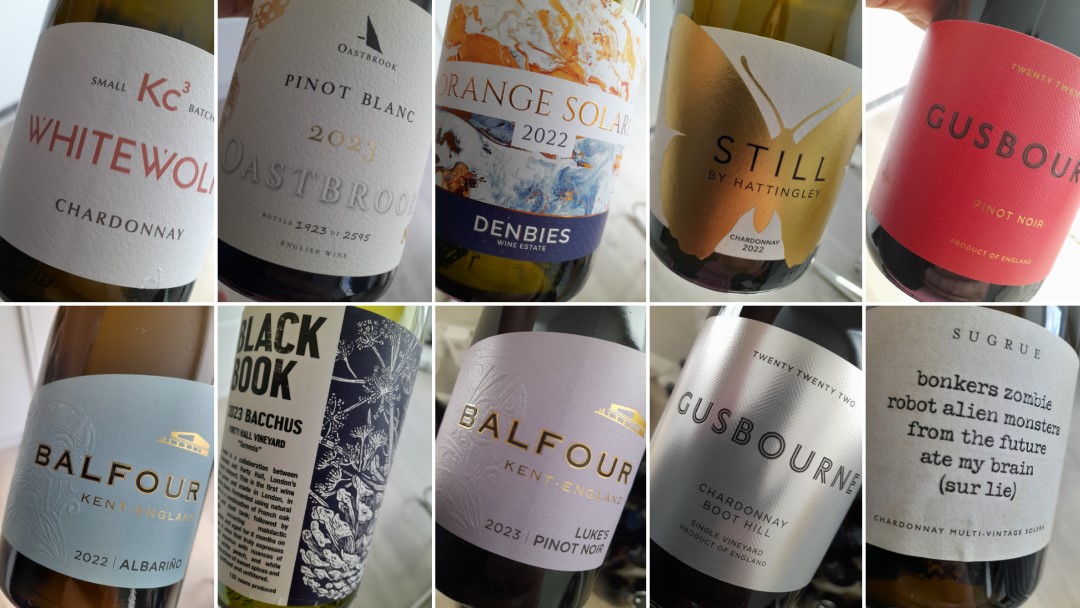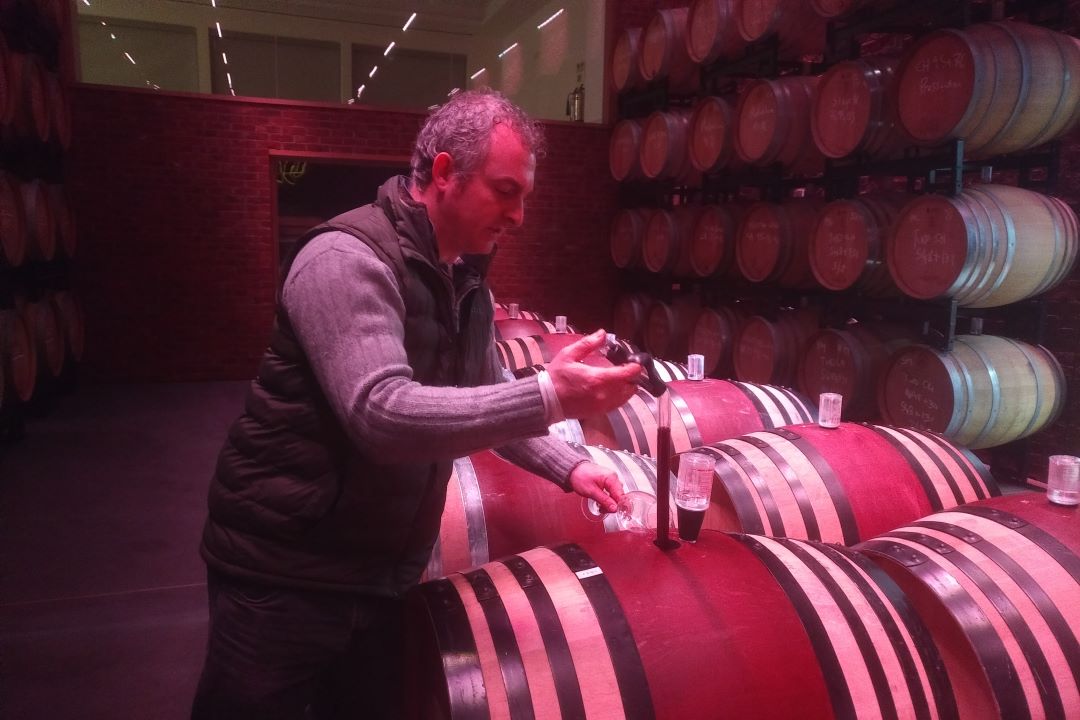Browse using the new Vinous website now. Launch →
Printed by, and for the sole use of . All rights reserved © 2015 Vinous Media
English Still Wine: Much Promise, Much Afoot
BY ANNE KREBIEHL MW | APRIL 15, 2025
Still wines, for now, play a minor part in the English wine landscape, eclipsed by the success of English sparkling wines, whose effervescent genesis I recounted in my recent report. England, an island in the North Sea, with its marginal yet moderate maritime climate and southern counties straddling the latitudes of 51 and 52 degrees, seems predestined to produce brisk, fresh sparkling wines. But what about the wines that do not sparkle?
A Checkered Past
Judging at regional competitions about a dozen or so years ago, I remember tasting often meagre English whites, with the odd exception, made mostly from varieties like Seyval Blanc and Madeleine Angevine, alongside Germanic crossings suited to these northerly climes. Reds were few and far between. I recall a stunning Pinot Noir from Stanlake Park that was a notable exception. A Merlot-Cabernet blend grown under a polytunnel in Devon remains memorable for entirely different reasons. In those days, English still wines were of a standard that could be sold to tourists at cellar doors when “proper” wines from Europe or the New World were conveniently absent. Overpriced for what they were, English still wines could not really compete. What happened in the past decade, however, is remarkable. Climate change, increased growing expertise and the exploration of new regions (hello, Essex!) have made all the difference. Much is afoot.

Still Wine Today
Wine GB, the British wine industry’s representative body, reports that still wine represented roughly between one-fifth and one-third of total production over the past eight years. Of this, two-thirds were white wine, with the remaining third split into varying proportions of Rosé and red (the balance tipping in favor of Rosé). In this report, however, there are more reds than Rosés.
Plantings reflect production. The top three varieties are Chardonnay with 1,228 hectares (ha), Pinot Noir with 1,141 ha and Pinot Meunier with 343 ha. This trinity is followed by 298 ha of Bacchus, 122 ha of Seyval Blanc and ever-decreasing patches of Solaris, Reichensteiner, Pinot Noir Précoce (a tricky, earlier-ripening mutation of Pinot Noir that seems to have found a natural home in England), Rondo and Pinot Gris. Pinot Blanc, Ortega, Sauvignon Blanc, Albariño, Riesling, Huxelrebe, Müller-Thurgau, Gamay, Pinotage and others are also planted but have too little surface to show up on the stats. Depending on your point of view, this is either a hodgepodge or a hotbed of experimentation. In any case, quantities are modest. How could it be otherwise when only 3,230 of the 4,209 hectares so recently planted are bearing fruit, and only 20-35% of these are made into still wine?
Who Makes the Wines?
The 70+ still wines in this report represent a beautiful spectrum. Some come from wineries that specialize in sparkling wine and have branched out into still wine production, like Gusbourne, for instance, whose first still Chardonnay dates to the 2011 vintage and first still red Pinot Noir dates to 2013. There are also wineries that focus on still wines, like Oastbrook in East Sussex, Danbury Ridge and Missing Gate (the latter two in Essex, but more on that later). The fact that still wines do not require years of lees-aging, a process that requires deep pockets to survive years without cashflow from sales, allows younger, independent winemakers to have a go as micro-négociants. Chris Wilson makes wines in a tiny windmill in Cambridge under his Gutter & Stars label (the literary-minded among you will smile at the allusion). Lynsey and Sergio Verrillo at Blackbook Winery produce their wines in a winery tucked under some railway arches in Battersea, London. Regionally, the wines come from as far west as Cornwall and as far north as Norfolk.

Liam Idzikowski, winemaker at Danbury Ridge, in his state-of-the art and artfully lit barrel room.
Eldorado Essex
Thirty-eight percent of the still wines tasted in this report contain fruit grown in the eastern county of Essex, while 32% were made exclusively from Essex-grown fruit. Why Essex, of all counties, should be deemed the new Eldorado of English still wines comes as a surprise to many. After all, this county extending from the less glamorous eastern fringes of London all the way to the North Sea suffers, both deservedly and undeservedly, from a rather poor reputation. My colleague Neal Martin, an Essex boy himself, aptly and humorously sketched his home county’s image in his portrait of Danbury Ridge. But Essex holds excellent cards when it comes to still wine: it is on the dry east coast of England—readers who love gardening may be familiar with Beth Chatto’s famous dry garden near Colchester. Not only is Essex drier than much of England, it is also sunnier and, what’s more, has clay in the soils. The best sites have rather special smectite clay with excellent shrink-swell potential. While this rings alarm bells for construction, it is brilliant for giving just enough but never too much water to vines, creating just the kind of positive stress a vine needs to channel its best energies into ripening grapes, whether the season is wet or dry. These characteristics make Essex very much still rather than sparkling wine country. It is here that US-based fine wine conglomerate Jackson Family Wines bought land to make still wines, the company’s first foray into England. One contract winemaking facility, or custom crush pad, opened in late 2024 just across the Suffolk border to cater to East Anglian growers, while another facility, in the Crouch Valley of Essex where most vineyards are, is set to open later this year. Such investment would simply not occur if there weren’t so much promise.
The Stars
Undoubtedly, the two still wine stars are Chardonnay and Pinot Noir. With a track record of excelling in cool and marginal climes the world over, these two chameleons shine in England. Chardonnay and Pinot Noir are what make me excited for still English wine. Chardonnay, while sometimes made in easy, juicy, fruity styles, has all the potential to yield wines of brightness, cut and tension, which will become even more obvious with vine age. Pinot Noir, in its own inimitable way, once again vindicates the idealists, the dreamers, the optimists with its beautiful expressions of England. A lot of Pinot Noir is grown in places that are getting very warm; in England, that is not the case. Here, you can still taste its climatic marginality in cooler years like 2021 or 2023. These vintages are where Pinot Noir shows us an inherent, innate part of its nature, something that is as essential as it is visceral, as vulnerable as it is triumphant, that allows those who dare to make a red wine against all odds, imbued with poetry and fragrance. Pale perhaps, and slender, but nonetheless true. In the warmer years, Pinot Noir beguiles with its silkiness and perfume. What promise!
I tasted the wines in this report in late 2024 in England.
© 2025, Vinous. No portion of this article may be copied, shared or re-distributed without prior consent from Vinous. Doing so is not only a violation of our copyright, but also threatens the survival of independent wine criticism.
You Might Also Enjoy
English Sparkling Wine: Effervescence and Reserve, Anne Krebiehl MW, February 2025
The Only Way Is Essex: Danbury Ridge, Neal Martin, April 2024
Albion Gets Serious: English Sparkling Wine, Neal Martin, July 2020
Show all the wines (sorted by score)
- Ashling Park Estate
- Balfour Winery
- Black Book Winery
- Black Chalk
- Camel Valley
- Danbury Ridge
- Denbies
- Flint Vineyard
- Greyfriars
- Gusbourne
- Gutter & Stars
- Hattingley Valley Wines
- London Cru
- Lyme Bay Winery
- Missing Gate
- Oastbrook
- Oxney
- Penn Croft
- Sandridge Barton
- Silverhand
- Simpsons
- Sugrue South Downs
- The Grange
- The Heretics
- Two Beacons Vineyard
- Vagabond
- Walgate
- Whitewolfe Estates
